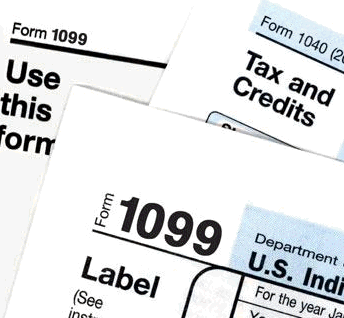What You Can Learn From Your 1099 Tax Forms
Apr 11, 2018 • Written by Paul Staib | Certified Financial Planner (CFP®), MBA, RICP®
Blog Home » Asset Allocation » What You Can Learn From Your 1099 Tax Forms

The first thing to know about 1099s is that there are several different subtypes: 1099-DIV, 1099-INT, 1099-R, 1099-MISC, and so on. The unifying theme among them is that they document that you received some type of income during the preceding year, whether from your investments, from working, or from other sources; that income may or may not be taxable. You won’t receive a 1099 from your tax-sheltered retirement accounts (i.e. IRAs) unless you’ve taken a withdrawal or some other action.
Most investors are familiar with the basic 1099-DIV and 1099-INT forms: the former reports dividends and capital gains from taxable investments during the prior year, and the latter depicts interest income received. Form 1099-B, meanwhile, contains any capital gains or losses realized in taxable accounts. Some investment firms amalgamate all of this information into a single consolidated 1099.
As you look over your 1099s, here are some of the key line items to focus on.
Am I taking a tax-efficient approach to dividends?
The first two boxes (or columns, depending on how your form is laid out) of 1099-DIV forms deal with dividends: Box 1a contains the total ordinary dividends you received, and Box 1b shows you which of those were qualified. Ideally, all of your dividends will count as qualified, because they’re eligible for a lower tax rate than nonqualified ones. Dividends from most U.S. companies, as well as qualified foreign corporations, count as qualified, though there are holding-period requirements to obtained qualified dividend tax treatment. By contrast, nonqualified dividends, from REITs and some foreign stocks, for example, are subject to your ordinary income tax rate.
If the figure in Box 1a is much bigger than 1b, that’s a cue to assess asset location: If you’re unnecessarily holding tax-inefficient investments producing nonqualified dividends in your taxable account, you may consider holding those in tax-sheltered investment accounts. And if you have dividend-rich holdings – even if their dividends are qualified – it’s also may be worth considering whether such holdings might make more sense in your tax-sheltered accounts.
Is it possible to minimize taxable capital gains?
Box 2a shows whether your mutual fund holdings made a capital gains distribution last year. (If you yourself made a sale, you’ll see that reflected on form 1099-B, not 1099-DIV). Such distributions are getting harder and harder to avoid in this long-running bull market: funds have gains on their books, and those gains must be distributed to shareholders when those appreciated securities are sold. Yet some funds, especially broad market equity ETFs and index funds and tax-managed funds, do a better job minimizing those capital gains payouts than others.
Do I understand how my foreign securities are taxed?
If you hold foreign stock funds in your account – or even U.S. focused funds that invest in foreign securities – Box 7 of 1099-DIV depicts any foreign taxes paid on those holdings for the year prior. Investors in foreign stocks have to pay taxes on their earnings in the company’s country of domicile, as well as to the U.S. The key to not getting taxed twice is to claim a deduction or credit for foreign taxes already paid.
In addition, the ability to deduct foreign taxes paid may make a taxable account a more attractive account for foreign stocks than an IRA or 401(k). Moreover, some dividends from foreign stocks aren’t qualified, so placing them within a taxable account may offset, at least in part, the value of any foreign tax credit.
Have I taken steps to maximize my tax-free income?
Box 10 of 1099-DIV depicts the amount of tax-exempt interest dividends that you received. If you’re in the 24% tax bracket or above, the income you receive from a municipal bond (or bond fund) will likely be higher than what the after-tax income you receive from a taxable account.
1099 DIV Box 11
This box displays any interest you have received from so-called private-activity bonds. While such bonds often pay higher interest rates than other types of munis, the downside is that they’re subject to the alternative minimum tax. (Such bonds tend to be especially prevalent in municipal money market mutual funds.) The good news is that the new tax laws going into effect in 2018 significantly increase the AMT exemption amounts. In addition, those full exemptions are available to taxpayers with significantly higher incomes – $500,000 for individuals and $1 million for married couples filing jointly – than was previously the case. That means that the AMT will affect many fewer taxpayers going forward than was the case in previous tax years.
No 1099 DIV
What if you didn’t receive a 1099-DIV from a taxable account that you know you hold? First, be aware that you won’t receive a 1099 from your tax-sheltered retirement accounts if you’ve just been making contributions; you’ll only get a 1099 if you’ve taken a distribution or some other action with the account. Nor will you receive a 1099 of any kind if your earnings were less than $10 (“de minimis” rules), though you’re still required to report those earnings to the IRS on your tax return.
Too Many 1099 DIVs
On the flip side, if you received many 1099s from different providers, that could be a signal that your portfolio is “busier” than it needs to be. You may want to consider ways to consolidate your accounts with a single provider or two, rather than maintaining multiple accounts across multiple financial institutions.
Related posts:

Paul Staib | Certified Financial Planner (CFP®), MBA, RICP®
Paul Staib, Certified Financial Planner (CFP®), RICP®, is an independent Flat Fee-Only financial planner. Staib Financial Planning, LLC provides comprehensive financial planning, retirement planning, and investment management services to help clients in all financial situations achieve their personal financial goals. Staib Financial Planning, LLC serves clients as a fiduciary and never earns a commission of any kind. Our offices are located in the south Denver metro area, enabling us to conveniently serve clients in Highlands Ranch, Littleton, Lone Tree, Aurora, Parker, Denver Tech Center, Centennial, Castle Pines and surrounding communities. We also offer our services virtually.
Read Next
5 Stealth Taxes That Can Impact Your Retirement
• Written By Paul Staib | Certified Financial Planner (CFP®), MBA, RICP®
Every year, an increasing number of retirees are impacted by one or more “stealth” taxes. While certain taxes may be…
Sources of Emergency Cash
• Written By Paul Staib | Certified Financial Planner (CFP®), MBA, RICP®
The current pandemic isn’t just a health crisis. For many households it’s a financial crisis as well. Unemployment claims and…
